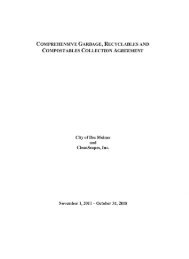CITY OF DES MOINES SHORELINE MASTER PROGRAM
CITY OF DES MOINES SHORELINE MASTER PROGRAM
CITY OF DES MOINES SHORELINE MASTER PROGRAM
Create successful ePaper yourself
Turn your PDF publications into a flip-book with our unique Google optimized e-Paper software.
Des Moines Shoreline Inventory and Characterization<br />
DATA GAPS AND RECOMMENDATIONS<br />
The following items have been identified as data gaps or additional information that would<br />
enhance the shoreline inventory and characterization. Where possible, recommendations are<br />
provided to address data gaps as the City moves forward with the comprehensive update of its<br />
Shoreline Master Program.<br />
• Additional information and analysis on stream sediment regimes for the City’s larger<br />
streams (Des Moines, Redondo, Massey and McSorley) would provide a base level of<br />
information for understanding past and current sediment regimes and would better inform<br />
shoreline management and restoration options.<br />
• More information and analysis on range of stream flow variability, including the timing,<br />
magnitude and spatial distribution for peak high and low flows for the city’s larger creeks<br />
(Des Moines, Redondo, Massey and McSorley Creeks) would provide a base level of<br />
information for understanding past and current flow regimes. Data collected under the<br />
City’s water quality monitoring program is a good start, but has only been collected on<br />
Des Moines, Massey, and the North Fork of McSorely Creek.<br />
• Improved mapping of the extent and location of beaches, backshore, flats, and subestuaries<br />
would better inform the evaluation of site-specific restoration opportunities.<br />
• Mapping of marine riparian zones has not been completed. Mapping of eelgrass beds is<br />
available, but not at a detailed scale. Improved mapping would better inform the overall<br />
management of habitat areas in the City.<br />
• A more detailed inventory and description of vegetation types and species composition<br />
found in marine riparian zones and subestuaries would better inform the overall<br />
management of habitat areas in the City. This could be accomplished by additional field<br />
reconnaissance.<br />
Page 54 March 2005



